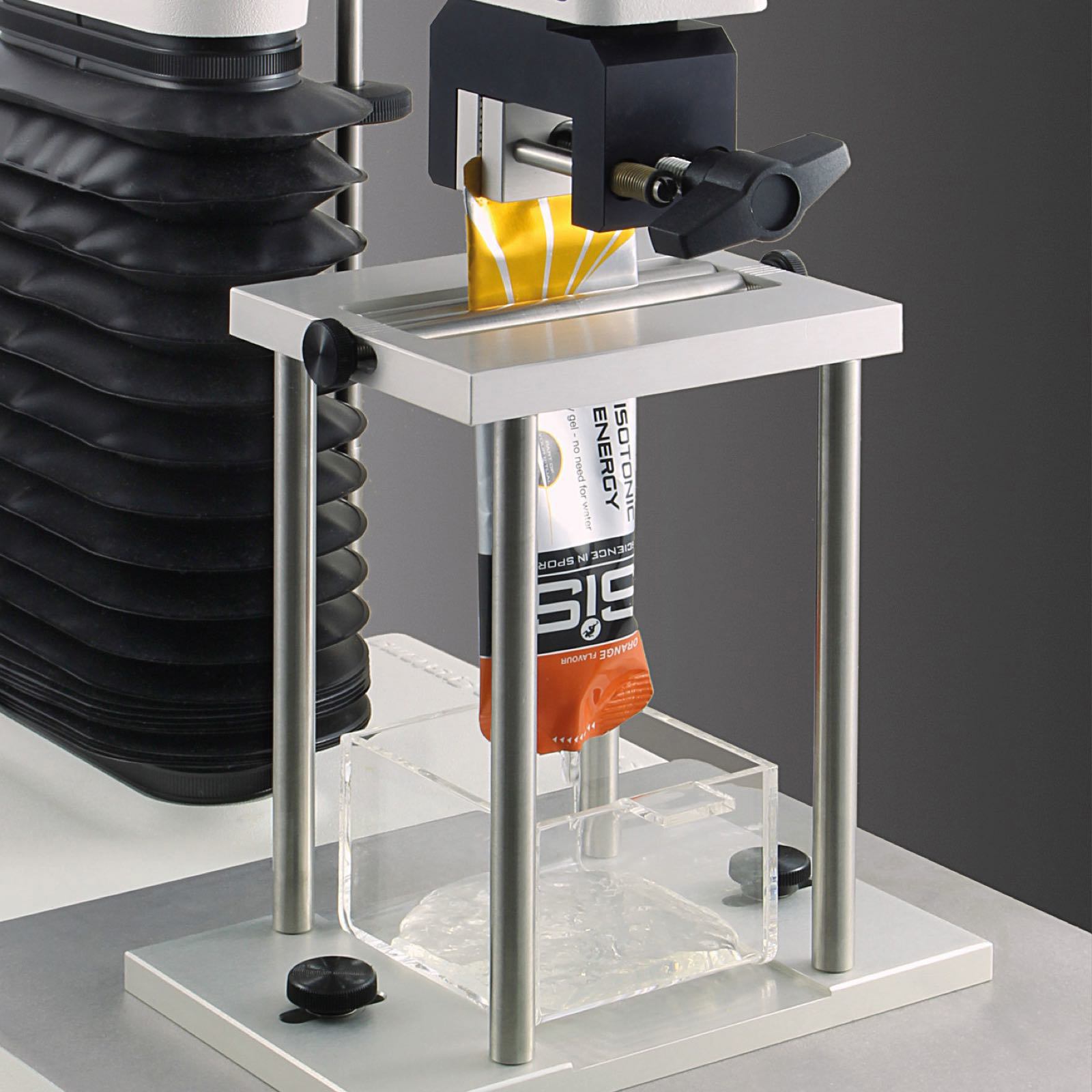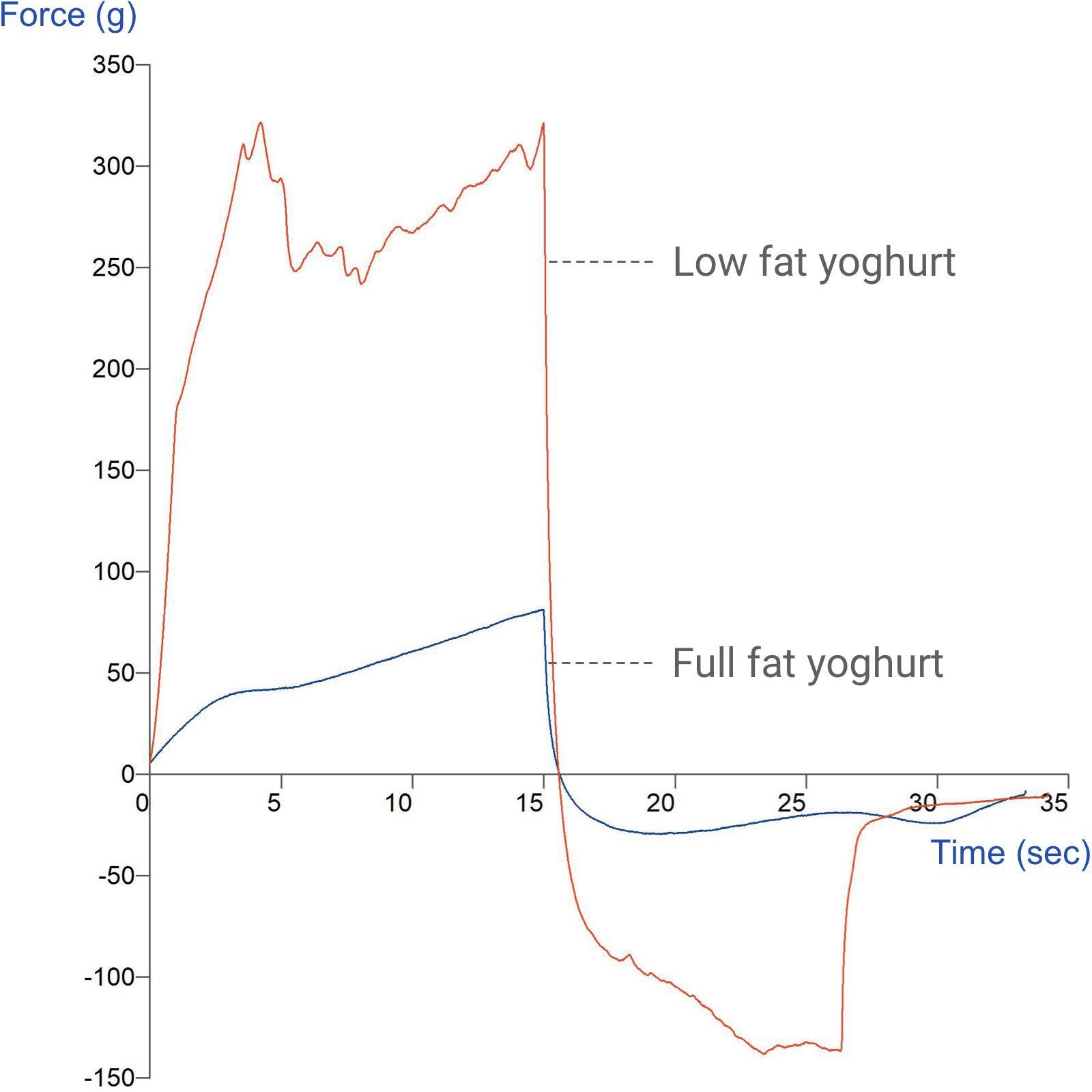How to measure consistency

Consistency: definition and importance
Consistency refers to the textural property of fluid or semi-solid products, such as dairy items, sauces, syrups, and pharmaceutical lotions. It is often associated with the firmness, thickness, or viscosity of these materials. Consumers frequently judge consistency by stirring or interacting with the product, and a Back Extrusion Rig (or other sample extrusion test) is commonly used to measure this property in lab settings. Consistency measurements help ensure that products not only meet technical specifications but also deliver the desired sensory experience to the end-user.
Further example applications of consistency testing
Consistency measurements using a Texture Analyser assess a product's thickness, extrudability, and firmness. These tests are crucial in industries like food, cosmetics, and pharmaceuticals, where product consistency impacts quality and usability. Here are some key applications:
- Cosmetic cream consistency: Evaluating the thickness and spreadability of creams, lotions, and ointments to develop the desired application properties. A well-formulated cream will have high consistency, showing smooth resistance to compression or spreading without air pockets or texture variations. Low consistency lotions or creams may show irregular force graphs, suggesting phase separation or poor formulation.
- Personal care products: Assessing the texture of toothpaste, shampoos, and hair gels to optimise product feel and performance.
- Yoghurt consistency testing: Assessing the consistency of yoghurt and dairy products to ensure they meet consistency standards. For example, measuring the force needed to extrude yoghurt from a container to evaluate its thickness.
- Adhesive and glue consistency: Testing the consistency of adhesives, glues, and sealants for specific applications. For example, measuring the force required to extrude an adhesive from a nozzle to assess its consistency.
- Pharmaceutical gel consistency: Evaluating the consistency and spreadability of pharmaceutical gels and creams by measuring the force needed to extrude a pharmaceutical sample from a tube to ensure uniform drug distribution. High consistency gels will extrude or compress uniformly, ensuring even dosage and texture. Low consistency gels or ointments may show irregularities in the force graph, indicating that the product may not spread evenly on application.
- Mayonnaise and salad dressing consistency: Assessing the thickness and flow properties of mayonnaise, salad dressings, and condiments. For example, measuring the force needed to squeeze mayonnaise from a bottle to evaluate its consistency.
- Sauce and gravy thickness: Testing the thickness/consistency of sauces, gravies, and soups to ensure desirable texture and mouthfeel.
- Inkjet ink consistency: Testing the flow properties of inkjet inks to ensure smooth operation through printer nozzles by measuring the force required to push ink through a nozzle to assess consistency.
In these examples, a Texture Analyser applies controlled forces/distances to assess the consistency of materials, providing insights for product quality and helping to optimise formulations for desired consistency attributes.
Typical probe/attachment used for measurement
In a typical consistency measurement test, extrusion is often used to simulate the action of sample movement during which consistency is usually determined. The sample is either extruded in a forwards (through a hole in the bottom of the packaging or extrusion vessel) or backwards (around a disc/cone in a vessel) direction as the Texture Analyser records the force throughout the test.
How to interpret the Texture Analyser graph
When measuring consistency, the force vs distance/time graph typically shows an increase in force to start movement of the sample followed by a gradual increase in force as distance increases or a plateau region. A smooth profile during sample flow is presented if the sample is homogeneous and of a free-flowing, thick/creamy consistency. The presence of particulates of the breaking up of an e.g. gelled structure, during the test would present as undulations in the force profile as particulates are encountered by the probe’s movement or the structure is potentially broken down which would cause peaks and drops in force.
 Typical curve indicating key analysis points of consistency test
Typical curve indicating key analysis points of consistency test
From the graph you can observe/obtain the following:
- Consistency
- Firmness
- Cohesiveness
- Tailing
- Stringiness
- Shortness
A full explanation of this curve and its analysis can be accessed within Exponent Connect software. Existing Exponent users can upgrade to Exponent Connect specification.
Below is a video example of how we can help you understand curve analysis for an example property.
Key factors affecting consistency measurement
- Temperature: The temperature of the sample can significantly influence its flow properties, affecting the measured consistency.
- Humidity: Ambient humidity levels can alter the moisture content of samples, potentially changing their consistency.
- Test speed: The rate at which force is applied during the test can influence the measured results, as materials may respond differently to varying speeds of deformation.
- Sample homogeneity: Ensuring uniform composition throughout the sample is crucial for accurate consistency measurements. Sometimes the product may possess particulates. These particulates will affect the repeatability of the results as a different number of particulates will come into contact with the extrusion disc for each test. If the product cannot be tested without the inclusion of particulates then it is recommended to use a larger container and larger extrusion disc for assessment. This effectively increases the volume of product tested under the surface and therefore serves as an averaging effect. Forward extrusion cannot be used as a suitable test type if particulates are present as the hole will become blocked and affect results.
- Sample handling: How the sample is handled prior to testing can affect its structure and, consequently, its consistency especially for shear-sensitive materials.
- Sample container: The dimensions and material of the container holding the sample can influence consistency measurements.
- Sample volume: The amount of sample used in the test can affect the results, especially for non-Newtonian fluids.
- Probe/attachment geometries: Different disc/annulus sizes may be used for various product types, affecting the absolute values obtained and the geometries should remain constant for comparison purposes.
Collecting additional measurements during your test

Acoustic Envelope Detector
The Acoustic Envelope Detector can by employed for any material which produces an audible noise when tested as it captures another dimension (i.e. sound) during the test which can also be analysed and used as a measured product feature.
Optimising consistency measurement and analysis: The Stable Micro Systems advantage
The Stable Micro Systems Texture Analyser stands out in optimising consistency measurements through its specialised extrusion rigs and versatile capabilities which precisely quantify liquid and semi-solid products.
The Texture Analyser's ability to measure consistency, cohesiveness, and viscosity index across a wide range of products – from dairy to pharmaceuticals – makes it exceptionally versatile. With a variety of testing options, comprehensive data analysis via Exponent Connect software, and unparalleled expertise in graphical interpretation, it provides deep insights into product consistency.
The Texture Analyser's industry-standard methodology, combined with Stable Micro Systems' support in method development and data interpretation, ensures accurate and relevant results. This makes it the ideal choice for researchers and manufacturers aiming to refine formulations and maintain high quality standards.
A choice of extrusion probes and industry standard method to imitate consumer interaction.
Comprehensive analysis of detailed force-distance-time profiles.
Ability to additionally capture synchronised video for better product understanding.
Adjust settings to match specific product requirements or simulate real-world usage conditions.
If you need help with your cohesion measurement, we offer unrivalled support.
Be guided through the steps to successful testing and analysis of cohesiveness.











